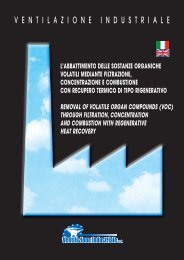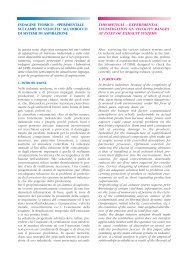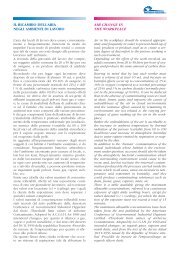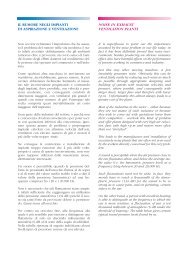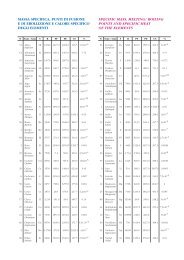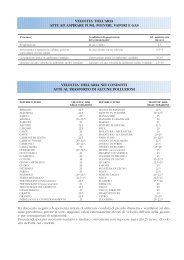impianti di combustione tipo rigenerativi regenerative combustion ...
impianti di combustione tipo rigenerativi regenerative combustion ...
impianti di combustione tipo rigenerativi regenerative combustion ...
You also want an ePaper? Increase the reach of your titles
YUMPU automatically turns print PDFs into web optimized ePapers that Google loves.
Ventilazione Industriale s.r.l. ha fornito alla società<br />
Fornaci <strong>di</strong> Manzano s.p.a. un combustore termico<br />
rigenerativo ad inversione <strong>di</strong> flusso, per la depurazione<br />
dei fumi <strong>di</strong> emissione provenienti dai forni <strong>di</strong><br />
cottura dei laterizi. L’impianto permette la termo<strong>di</strong>struzione<br />
delle SOV presenti, mantenendo la temperatura<br />
in camera <strong>di</strong> <strong><strong>combustion</strong>e</strong> uguale o superiore<br />
ai 750°C, e tempi <strong>di</strong> contatto superiori a un<br />
secondo. Le sostanze organiche volatili nell’emissione<br />
sono riconducibili agli ad<strong>di</strong>tivi aggiunti alle<br />
argille (polistirolo, fanghi <strong>di</strong> cartiere, ecc.), necessari<br />
per la produzione <strong>di</strong> laterizi alleggeriti in pasta,<br />
con una elevata capacità <strong>di</strong> isolamento acustico,<br />
ottimo isolamento termico e con una notevole inerzia<br />
termica. L’elevata temperatura dei fumi <strong>di</strong> emissione<br />
dei forni <strong>di</strong> cottura può essere sfruttata per<br />
l’ottenimento <strong>di</strong> aria calda T = 70°C ~ utilizzata poi<br />
negli essiccatoi <strong>di</strong> produzione laterizi, senza determinare<br />
un sostanziale aumento <strong>di</strong> consumo <strong>di</strong><br />
combustibile per il mantenimento della temperatura<br />
in camera <strong>di</strong> <strong><strong>combustion</strong>e</strong>.<br />
I risultati processistici ottenuti riguardanti le emissioni<br />
in termini <strong>di</strong>:<br />
Portata nominale 40.000 Nm 3 /h<br />
Temperatura a camino 140°C<br />
sono ampiamente al <strong>di</strong> sotto rispetto alle normative<br />
<strong>di</strong> riferimento:<br />
COT < 1 mg/Nm 3<br />
Benzene < 1 mg/Nm 3<br />
NOx < 40 mg/Nm 3<br />
Le emissioni della produzione <strong>di</strong> laterizi con l’ausilio<br />
<strong>di</strong> ad<strong>di</strong>tivi, deve sottostare al recente D.M. del 5 febbraio<br />
1998.<br />
Ventilazione Industriale s.r.l. has supplied Fornaci<br />
<strong>di</strong> Manzano s.p.a. with a <strong>regenerative</strong> type of incinerator<br />
with reverse flow, for cleaning emission flows<br />
coming from brick kilns. The <strong>combustion</strong> plant<br />
allows incineration of the VOC present, by hol<strong>di</strong>ng<br />
the <strong>combustion</strong> chamber temperature equal to or<br />
higher than 750°C, and contact times greater than<br />
one second. The Volatile Organic Compounds in<br />
the emission may be due to the ad<strong>di</strong>tives added to<br />
the clay (polystyrene, paper mill sludge, etc.),<br />
required for production of light-weight brick in<br />
paste form, with high sound insulation capacity,<br />
optimum thermal insulation and considerable thermal<br />
inertia. The high temperature of the emission<br />
fumes of the brick kilns can be exploited to obtain<br />
hot air T = 70°C ~ subsequently used in dryers in<br />
brick production, without causing a substantial<br />
increase in fuel consumption in order to hold the<br />
temperature in the <strong>combustion</strong> chamber.<br />
Process results regar<strong>di</strong>ng emissions in terms of:<br />
Nominal flow rate 40,000 Nm3/h<br />
Stack temperature 140°C<br />
are amply below those specified by the normative<br />
standards:<br />
Tot. organic C<br />
< 1 mg/Nm3<br />
Benzene<br />
< 1 mg/Nm3<br />
NOx<br />
< 40 mg/Nm3<br />
The emissions of brick production with the aid of<br />
ad<strong>di</strong>tives, must abide by a recent Italian Ministerial<br />
Decree 5th February 1998.<br />
Impianto <strong>di</strong> <strong><strong>combustion</strong>e</strong> <strong>di</strong> <strong>tipo</strong> rigenerativo da 25.000 Nm 3 /h Regenerative incinerator plant, 25,000 Nm 3 /h<br />
8




